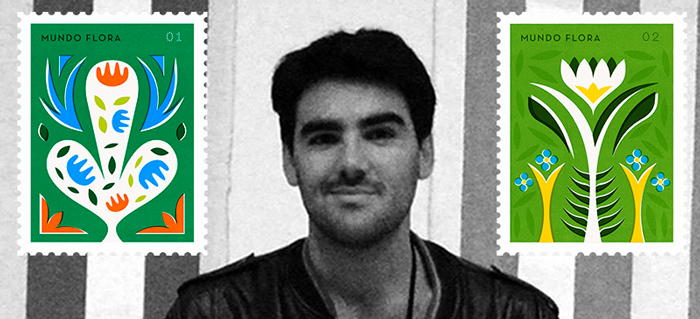
Bold Steps to a Creative Future: An Interview with Martin Azambuja
17 December, 2015Martin Azambuja is one of those designers whose work manages to playfully invade your day to day reality without you realising the process is happening. One of those people behind the ubiquitous flow of images in magazines, products, places and events. You check yourself because, and this happens frightfully rarely, you pause for a minute and enjoy the visual craft of something put together carefully, of colours pleasing to both eye and mind.
At 27 years old, Azambuja has put himself firmly at the forefront of Uruguayan graphic design and illustration. His studio, Mundial, barely three years old, now finds itself in the enviable position of ‘designing the dreams’ of a generation of young entrepreneurs in Uruguay, the most well known of which, Birra Bizarra, features a roster of circus characters (and accompanying brews) that look like the wonderful love child of Popeye and Desperate Dan.
His work, he admits, is openly influenced by the sixties and seventies. “All my references” he says with a smile “come from that period, a time where illustration was fundamental, designs where everything had to be done by hand” His style, with heavy use of grids and geometry, is clearly influenced by the granddaddy of Uruguayan art, Joaquin Torres Garcia, and he laughs at the shadow this pivotal figure still casts over the local scene.
Stepping out of that shadow takes work, and Azambuja takes pride in having found ‘a couple of incredible examples of books and work by a great generation of Uruguayan artists’. Work, such as Imprenta As, he describes as “chock full of colour, in the same vein as other figures such as Carlos Pelleiro.” The bold use of colour, he says, is surprising in Uruguay, a country not necessarily known for the prevalence of tropical flavour in its national colour palette.
His own style? He smirks at the question. “My style isn’t so much a specific thing, but there are certain decisions that I always take that have become recognisable.” “Sometimes”, he adds “I feel the development of a style is the implementation of a formula, of repetition.” It’s a fine line, he argues, between becoming commercially successful for something you can easily repeat, and the desire to try new things. Finding time to stop, take stock, explore Montevideo and simply sit down and draw, scan, try out new tools is a process that avoids his own creative stupor.
The influences of the sixties is clear. His work seems, at times, taken straight from a world where space travel was on the verge of becoming a tangible reality, of astronauts as superheroes and of the vibrancy of colour reflecting the vibrancy of the social fabric of the day. It is a spirited sideswipe that catches you unaware with a zesty, vivacious, fundamentally uplifting invitation to smile. An innocence that hints at the liberal joie de vivre Azambuja clearly seasons life with. There is a delightful history to each design that comes through at first glance, and deepens when you realise just how well cut the design he tailors has been measured.
The interplay between the local and the international is key to Azambuja’s work. As a graduate of the Universidad ORT Uruguay, he started work as a junior at a local ad agency. Fed up with changing “details I didn’t think made a difference”, establishing Mundial with his partner Fran was the first step on the road to creatively communicating that same go-get em spirit of the brands he now works with.
It is a journey that has taken them from respected publications such as Monocle and Wired to local projects where the interaction with a group of young, driven and passionate creators has created a territory of fertile and friendly innovators diversifying with a concrete identity of their own. It’s a mix Azambuja likes. “It’s great to work with the big international clients, with a quick turnaround, but it’s also great to support people here doing their own stuff.” He seems to clearly enjoy the fact that, at the moment, Uruguay is a good place to work, and the pull of the traditional cities and their star studded studios is tempered by satisfaction at jobs well done in his hometown. It’s an opinion that is becoming increasingly frequent amongst the burgeoning creative class in Uruguay. They’ve realised that Montevideo, so long the epitome of a migrant stoicism in the face of the flashier Latin American capitals, is becoming a place where previously foreign words: co-working, collaboration, innovation, form part of a new creative lunfardo.
We end the interview talking about the sounds, arts and colours that this blog epitomises. “Uruguay has its own richness, you just have to look a little deeper than in other places” he laughs. Because whilst this young designer is proving that the work he does is in demand internationally, he feels at home, literally and metaphorically, with the fact that Uruguay, and its surprising, rewarding, colourful past and present is right now allowing him room to grow.
Follow Sounds and Colours: Facebook / Twitter / Instagram / Mixcloud / Soundcloud / Bandcamp
Subscribe to the Sounds and Colours Newsletter for regular updates, news and competitions bringing the best of Latin American culture direct to your Inbox.





